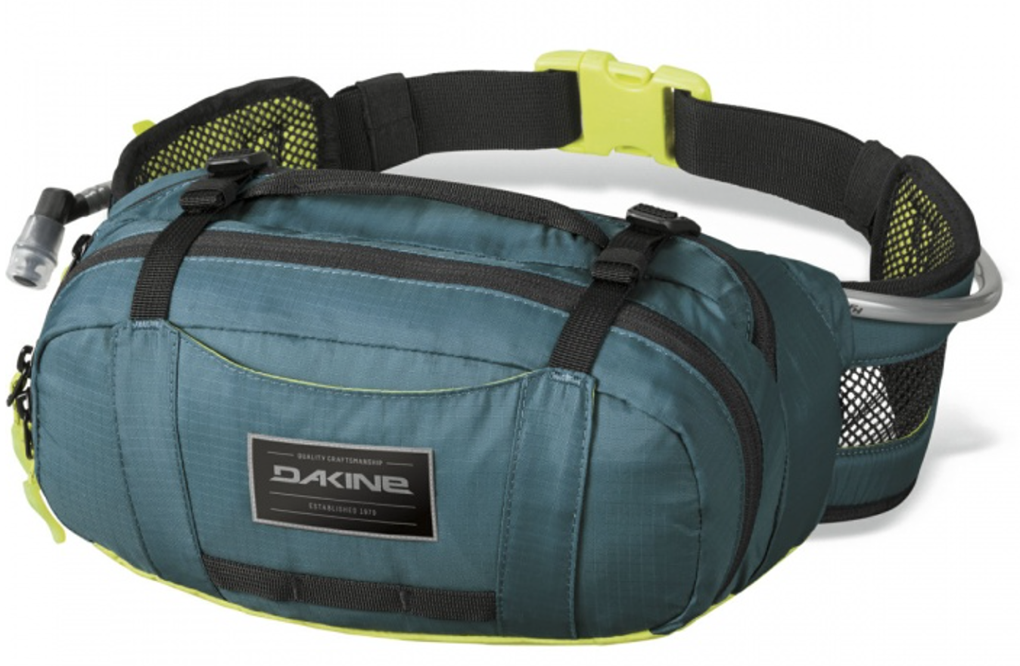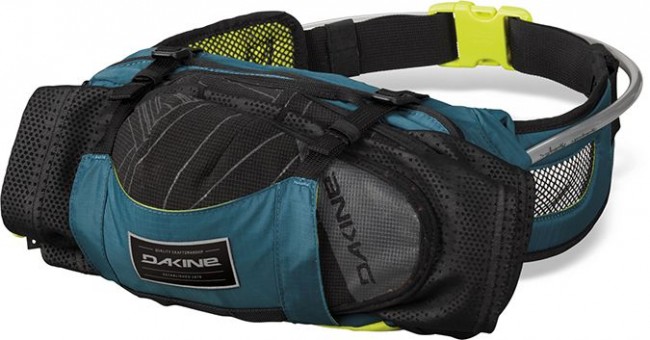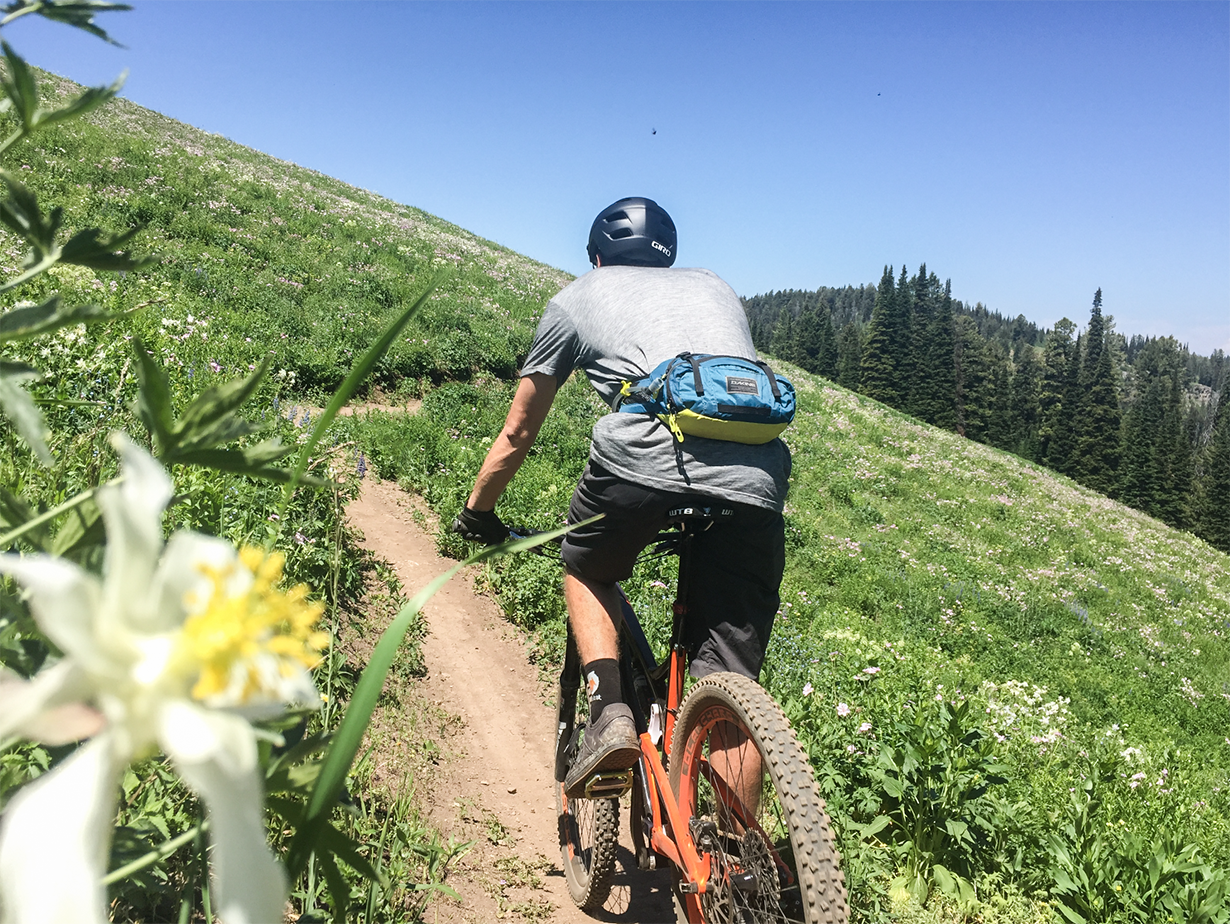
Dakine Low Rider 5L
Volume: 5 Liters
Stated Features:
- Phaser bite valve
- Breathable air mesh and foam backpanel
- Fleece-lined padded phone pocket
- Internal organizer pockets
- External attachment straps
- Safety light attachment
MSRP: $65
Test Locations: Grand Targhee, Teton Pass, ID; Whistler, BC
Days used: 12
Intro
Last year, Marshal Olson revealed that he’s been wearing a hydration hip belt (the kind designed for runners) while mountain biking, and made a compelling argument for the UltrAspire Impulse.
While fanny packs might always have some sort of stigma attached to them, and will never have the capacity of a full-on pack, I’d recommend taking a good look at what you’re carrying in your current hydration pack and assessing whether you could gain some comfort and breathability by swapping to a fanny pack.
Why a Fanny Pack?
First off, the Low Rider is technically a hip belt, not a fanny pack, but that distinction may be a little too nuanced for many. The Low Rider is different from hydration belts like the one Marshal reviewed in that it has a bladder, like a typical hydration pack, instead of water bottles.

In the past, I’ve either ridden without any pack (and rolled the dice by not bringing tools and parts on the ride), or used a full-on hydration pack usually with a camera inside. A fanny pack like the Low Rider lets me bring along a repair kit and more water than a typical cage-mounted bottle, without having anything on my back or shoulders. I also notice the Low Rider bouncing around less when pedaling and when riding more technical trails. It also concentrates weight lower around my waist instead of my shoulders which helps keep my center of gravity low, something I appreciate when riding more difficult trails.
I opted for the Low Rider over a pack like Marshal’s UltrAspire since I’d rather hydrate with a hose instead of messing with water bottles that can be hard to put back in the pack and can come loose.
Bladder and Hose
The Low Rider comes with a 2-liter reservoir from Hydrapak. It’s different from a typical, vertical back bladder since it’s wider than it is tall to fit the contours of your back. The bite valve has no lock switch, and wraps around the rider’s waist to clip to the hip belt. There is no clip to attach it to your jersey like some of Osprey’s running-oriented hip belts.
I found that while it’s not as easy to use as a shoulder-mounted valve or a magnetic system like Osprey’s, it’s not too difficult to use when spinning less demanding sections of trail.
I found the 2-liter capacity to be about right. Most frame-mounted bottles get you about .65 litres each, and given that more and more frames are foregoing usable bottle mounts altogether, it’s hard to carry much water on the bike without a traditional hydration pack. Fully loaded at 2 L of water, the Low Rider is heavy, and I definitely notice it moving a little on my back. But it easily carries enough water for a full day on the trail.
Pockets
The Low Rider has two main pockets, a big one close to the back for the bladder, and a slightly smaller front pocket that has two divided pockets for tools and tubes, as well as two zippered mesh pockets.
The main hydration pocket is very big, and with the 2 L bladder fully loaded, I can still fit a few energy bars and some sunglasses on top. Without the bladder, I can fit my Sony A7II camera along with a few batteries and memory cards, plus my Strafe Scout Jacket.
The smaller front pocket has room for a few beers or spare tubes, plus more than enough space for multi-tools, a mini pump, and the usual small parts and accessories necessary for trailside repairs.
While the Low Rider pack definitely lives up to its stated 5 L capacity, when fully loaded, I certainly noticed the weight on my back. However, with the hydration bladder filled about half way and no extra layers stuffed in. I don’t really notice or think about the pack while riding.
Pad Flap
The Low Rider has a flap on the back with two hooked buckles to carry pads or an extra layer. When closed, this flap makes it impossible to open either pocket all the way, and the hooks aren’t as easy to remove as a traditional buckle.

But this flap earns its keep if you typically end up hauling more stuff than will fit in the main pockets. It holds a stuffed jacket securely, as well as knee or elbow pads. I also did one long climb with my full-face helmet strapped through it, and found that the Low Rider did a surprisingly good job keeping my helmet securely attached and out of the way.
Riding Performance
On the trail, I find the Low Rider to be much less noticeable than a traditional hydration pack, and when it’s not fully filled, the pad flap helps cinch the pack down so that gear doesn’t flop around in the bag. While it’s not as spacious as a regular backpack, it still fits enough gear and water for all-day rides, and the fact that you can swap out the bladder for a camera means it’s great for shorter days I don’t need water, but do want to take photos.

When stopped, you can just spin the pack around your waist to grab a gel or bar, instead of having to unbuckle the waist and sternum straps of a traditional pack and take it off.
The padded mesh waist belt breathes well and keeps the pack secure, even on rougher trails, as long as the bladder isn’t totally filled.
Overall, I find that biking with the Low Rider is much more convenient and comfortable than a traditional hydration pack, and I don’t sacrifice too much volume or utility.
Bottom Line
Dakine’s Low Rider 5L pack is a very good option for riders who want to ditch the traditional backpack but still carry enough water and tools for long rides. Although it doesn’t have as much capacity as a traditional hydration pack, it strikes a happy medium while being more comfortable, and and enabling you to carry your pack weight lower.
